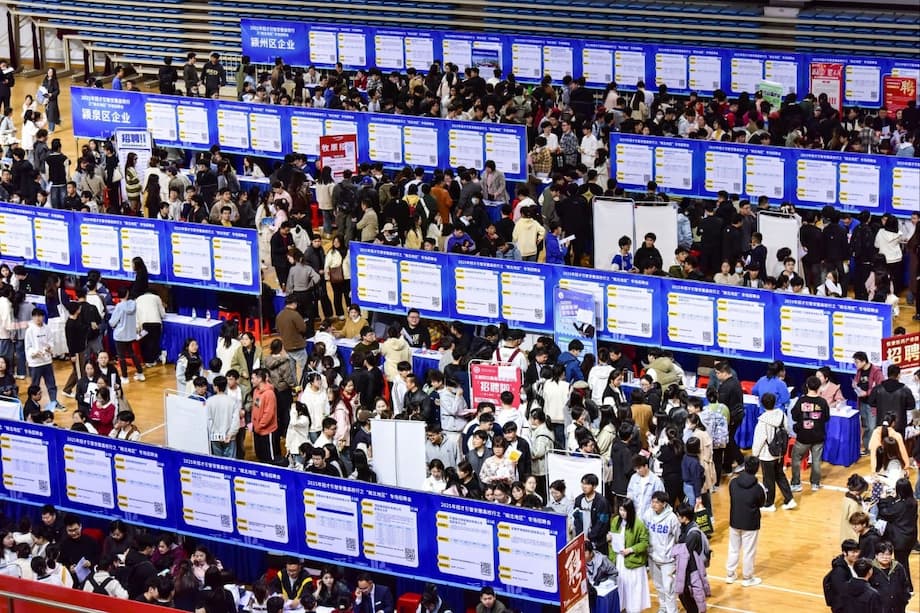A fragile recovery meets a flood of graduates
China’s urban youth jobless rate climbed to 18.9 percent in August for people aged 16 to 24 who are not in school, according to official data. That is the highest level since the government changed how it counts young job seekers in late 2023. The jump from 17.8 percent in July underlines how a wave of new graduates has met a labor market still weighed down by weak demand and a long property correction.
- A fragile recovery meets a flood of graduates
- What changed in the data and why it matters
- The economic backdrop behind the weak hiring
- A mismatch between degrees and available jobs
- Life on the job hunt
- The rise of gig work and automation risk
- How authorities are trying to respond
- What it means for growth and society
The latest batch of university graduates is the largest in China’s history. About 12.2 million students finished their degrees this summer, adding pressure to a market where many employers remain cautious about new hiring. The nationwide survey based jobless rate across all ages edged up to 5.3 percent in August. Youth unemployment had been easing into early summer, then turned sharply higher as campus leavers entered the search for full time roles.
What changed in the data and why it matters
China halted publication of youth unemployment data in mid 2023 after the earlier metric hit a record 21.3 percent in June of that year. In December 2023, the National Bureau of Statistics resumed the series with a narrower definition. The new measure excludes students, which lowered the rate on paper but still leaves it high by historical standards.
What the rate does and does not measure
The youth unemployment rate is a monthly urban survey that tracks young people who are available for work and actively looking, but do not have jobs. It focuses on a slice of the labor force that is particularly sensitive to economic cycles and sector shifts.
- It covers 16 to 24 year olds who are not enrolled in school and who live in cities and towns.
- It excludes full time students and does not estimate joblessness in rural areas.
- It does not count discouraged job seekers who have stopped searching.
- It is a rate, not a headcount, and it changes with the size of the labor force and with participation.
The reworked gauge still shows a labor market under strain for young people. Based on official figures, youth unemployment in 2025 started at 16.1 percent in January, rose to 16.9 percent in February, eased to 14.5 percent by June, then jumped to 17.8 percent in July before reaching 18.9 percent in August.
The economic backdrop behind the weak hiring
Growth indicators have cooled. Industrial production expanded 5.2 percent in August from a year earlier, while retail sales rose 3.4 percent. Fixed asset investment in the first eight months grew 0.5 percent, the weakest pace for that period since 2020. Consumer prices fell 0.4 percent year on year in August, a sign of deflationary pressure that tends to make companies more cautious about pay and hiring.
The property slump remains a major drag. Real estate investment dropped 12.9 percent in the first eight months of 2025, and sales of new commercial buildings by floor area fell 4.7 percent. Construction, household goods, and local government revenue linked to land sales have all felt the squeeze. External headwinds have added to the strain, with persistent trade frictions and slower foreign orders weighing on factories in export heavy regions.
A mismatch between degrees and available jobs
The heart of the problem for graduates is a growing mismatch. Hiring in real estate, private education, and parts of the tech sector has been tight since the pandemic and policy changes earlier in the decade. Many university leavers chase office roles with predictable hours and benefits, yet the fastest growth in openings has been in roles that require vocational skills, hands on manufacturing experience, or sales.
Companies in new energy, equipment manufacturing, logistics, and healthcare are adding workers, but they often want specific credentials or on the job training. At the same time, the market for generalist white collar roles has become more demanding. Many entry level posts ask for experience that fresh graduates do not have. Some employers have narrowed their intake to reduce costs, leaving a backlog of qualified candidates competing for fewer seats.
Life on the job hunt
For many students, the first months after graduation have been a trial. Maggie Li, a recent hotel management graduate from Hebei province, began job searching in early August after an offer she had accepted was suddenly withdrawn. She shifted her focus to administration and human resources roles in Beijing. Multiple interviews led to no suitable offer, and two positions turned out to be different from what was advertised.
He Yue, a computer science graduate based in Beijing, has been looking for more than two months for a role that fits her skills. She described the tenor of the search in blunt terms.
The market is quite rough, she said.
Stories like these capture a wider pattern. Some graduates accept lower pay to secure a start, work outside their field, or rely on temporary gig work while they keep applying. Others extend their studies to wait for a better market, which delays income and can amplify financial stress on families.
The rise of gig work and automation risk
Flexible work has absorbed part of the shock. More than 200 million people in China are involved in flexible employment by government estimates, covering delivery, ride hailing, live streaming, and other platform mediated jobs. For young people, gig work can provide a quick path to earnings and a bridge while they keep searching for longer term roles.
These jobs offer income but less stability. Benefits are limited, hours can be unpredictable, and competition is intense. Technology is reshaping the market as well. Drones and automated warehouses are advancing in logistics, and autonomous driving is developing, which could cap future demand for some delivery and driving roles. That leaves many young workers trying to balance immediate cash flow with upskilling to move into more resilient fields.
How authorities are trying to respond
Officials have rolled out measures to ease the pressure on new graduates. A campaign running from July to December targets jobless youth and college graduates with services such as career guidance, job referrals, and training opportunities. Local governments have advertised subsidies for firms that hire graduates, expanded public internship programs, and encouraged grassroots service posts in smaller cities and rural areas. Public sector employers and state firms have maintained recruitment drives, though competition is fierce. In one example, a major state energy company received more than one million applications for fewer than eight thousand openings.
Policy actions underway
- Job matching services and hiring fairs tied to peak graduate months.
- Training vouchers and subsidized courses in manufacturing, digital skills, and elder care.
- Incentives for small and midsize firms that convert interns into full time employees.
- Support for entrepreneurship, including tax relief and simplified business registration.
- Expanded recruitment in the public sector, including teaching, medical support, and community services.
The common challenge is scale. The number of applicants far exceeds the number of stable entry level roles in the most sought after cities. Training quality varies, and programs need to match real employer needs in growth sectors. Employers say they value practical skills and soft skills, including communication and teamwork, which are not always the focus of formal degrees.
What it means for growth and society
A prolonged youth job crunch can weigh on consumer spending. Young workers spend on rent, travel, dining, and electronics when they feel secure. High joblessness lowers that spending and makes it harder for households to plan for big purchases. That matters for an economy trying to rely more on domestic demand as property and exports lose momentum.
There are social effects too. The term




